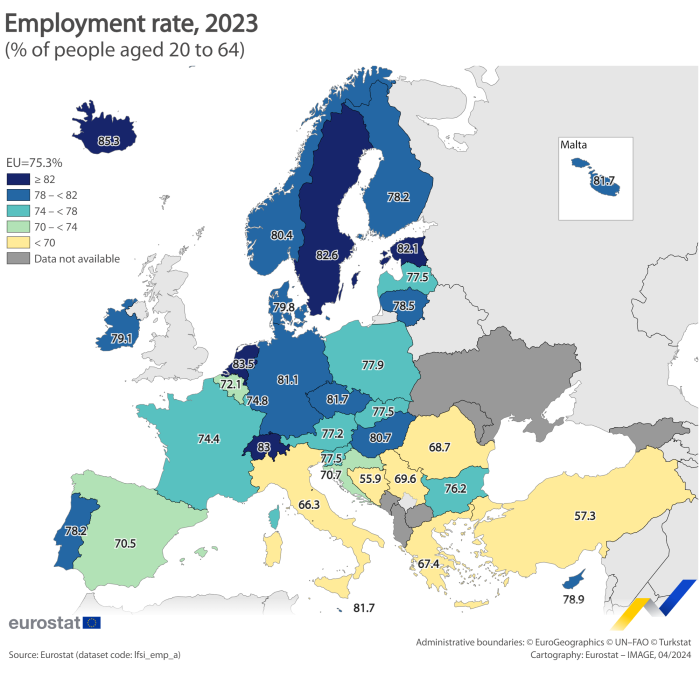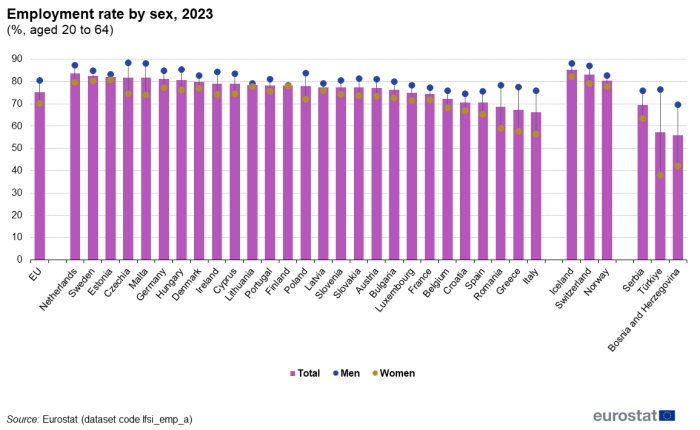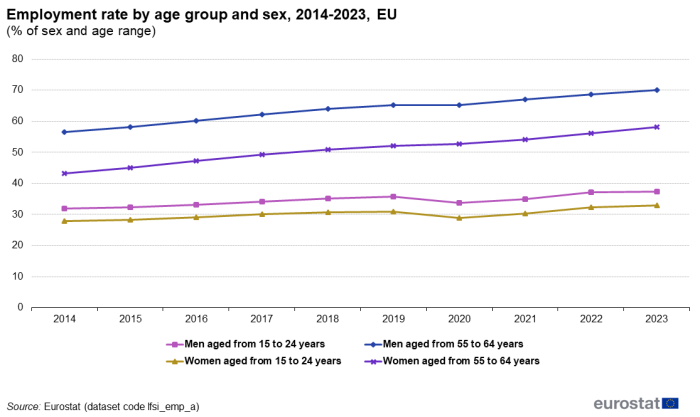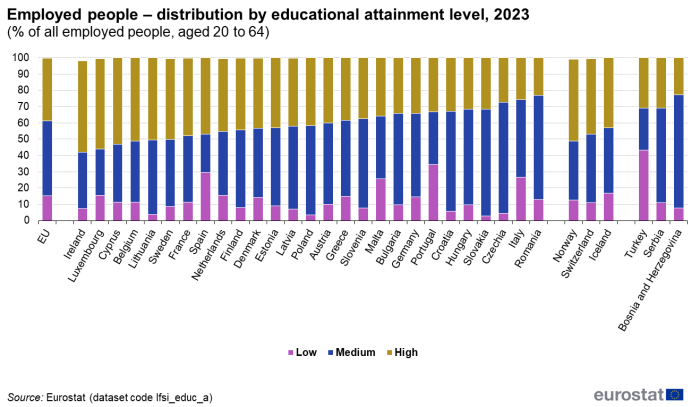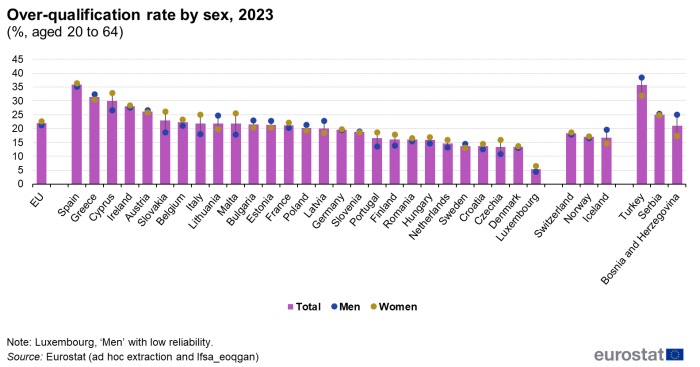Employment - annual statistics
Data from April 2024
Planned article update: 27 April 2025
Highlights
This article presents the most recent EU annual statistics on employment based on the EU Labour Force Survey (EU-LFS). It shows the employment rate by sex, age, and education for the EU as a whole, as well as for each EU Member State, for three EFTA countries (Iceland, Norway, and Switzerland) and three candidate countries (Bosnia and Herzegovina, Serbia and Türkiye). Employment rate is the percentage of employed persons in relation to the comparable total population. The article presents also information on the over-qualification rate among employed people with tertiary education.
Full article
Employment in 2023 compared with the EU target
In 2017, the European Commission, the European Parliament, and the Council jointly introduced the European Pillar of Social Rights Action Plan, aimed at promoting fair and efficient labour markets and welfare systems across Europe. To achieve this goal, the EU has set three targets for 2030, one of which is to attain a 78 % employment rate. In 2023, the number of employed people aged 20-64 years in the EU totalled 195 296 000, accounting for 75.4 % of all people in the corresponding age group. The employment rate has moved steadily closer to the EU target, increasing from 70.9% in 2017 to 75.4% in 2023. Across EU countries (see Map 1), 13 countries reported an employment rate exceeding 78 %, while 11 countries fell within the range of 70 % to 78 %, and the remaining three countries had employment rates below 70 %.
Employment rates in six EU countries surpassed 81 %: The Netherlands leading with 83.5 %, followed by Sweden (82.7 %), Estonia (82.1 %), Czechia and Malta both (81.7 %), and Germany (81.3 %). By contrast, Romania (68.7 %), Greece (67.4 %), and Italy (66.3 %) had employment rates below 70 %.
As part of its commitment to promoting inclusive employment, the European Pillar of Social Rights Action Plan has set a goal to reduce the gender employment gap. In 2023, the employment rate for people aged 20-64 years in the EU was 75.4 %. However, there is a significant gap between the employment rates of men and women (see Figure 1). While the EU's male employment rate stood at 80.5 %, the EU's female employment rate was 70.2 %, resulting in a gender employment gap of 10.3 pp.
Six EU countries have greater gender employment gaps than the gap for the EU as a whole. These countries include Poland, Czechia, Malta, Romania, Italy, and Greece. The widest gender employment gaps were observed in Italy (19.5 pp) and Greece (19.8 pp) where just over half of the female population was employed, compared with around three quarters of the male population.
Overall, in all EU countries, the employment rate of men is higher than those of women. However, the gender employment gap was relatively narrow in Baltic countries (Lithuania, Latvia, and Estonia) with gaps of around 3 pp or less, while in Finland the gap was almost negligible (0.2 pp).
Employment of men and women by age groups
Figure 2 illustrates the trend in the employment rate for men and women in the youngest and oldest age groups in the sense of active working age. The data from 2023 indicate that in the EU young men aged 15-24 years had a higher employment rate (37.3 %) than their female counterparts (33.1 %). For those aged 55-64 years, the employment rate was 70.1 % for men and 58.1 % for women. This highlights the widening gender employment gap with age: 4.2 pp for age group 15-24 years and 12.0 pp for 55-64 years.
The trend shows that the employment rate for those aged 55-64 years has been on an upward trajectory and is less prone to fluctuations, even during the COVID-19 pandemic. Between 2014 and 2023, there was a significant increase of 14.8 pp in the employment rate for women aged 55-64 years, while men in the same age group saw an increase of 13.6 pp. For those aged 15-24 years, the employment rate increased equally by 5.3 pp for men and women.
Employment by level of education
The level of educational attainment has a significant impact on the employment rate (see Figure 3). In 2023, in the EU, the employment rate for people aged 20-64 years who had attained a high level of education was 86.3 %, much higher than the rate for those who had only completed a low level of education, which was 58.3 %. It is worth noting that a high level of education refers to tertiary education, spanning short-cycle tertiary, bachelor's, master's or doctoral levels (or equivalents; ISCED levels 5-8), while a low level refers to (at most) primary or lower secondary education (ISCED levels 0-2). The EU employment rate for people who had completed their education at a medium level, i.e. upper secondary or post-secondary non-tertiary education (ISCED levels 3-4), was between the two previous rates in 2023, at 74.6 %.
Another aspect to consider is the gender employment gap by educational level. The employment gap between men and women widens as the level of educational attainment lowers. In 2023, among people with a high level of education, the gender employment gap was 5.2 pp. However, it was 11.6 pp for those with a medium level, and 21.6 pp for those with a low level of educational attainment.
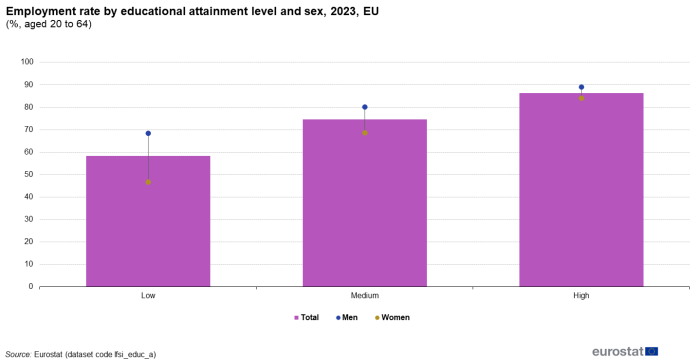
Source: Eurostat (lfsi_educ_a)
Figure 4 illustrates the trend in the employment rates of people aged 20-64 years by educational attainment level. The changes over the 10 years are visible. Between 2014 and 2023, the employment rate for people with a low level of education increased by 7.3 pp, marking the most considerable change recorded over this period. Over the same period, the rate for employed people with a medium level of education increased by 5.3 pp. Conversely, the employment rate for people with a high level of education increased by 4.7 pp.
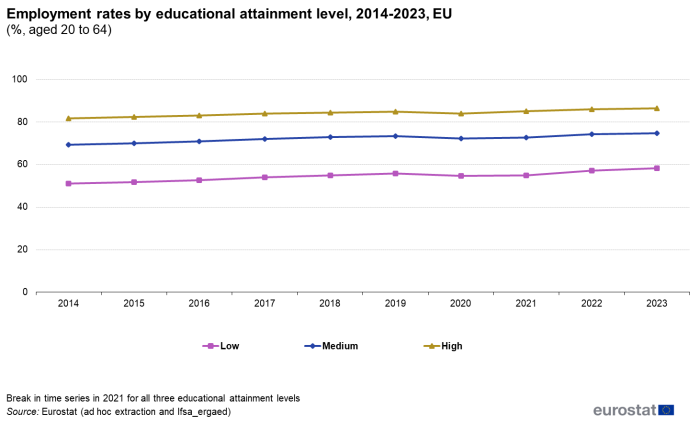
Source: Eurostat (lfsi_educ_a)
Finally, Figure 5 presents information at national level on the proportion of employed people by education attainment level among all employed people, age group 20-64 years. The highest proportions of employed people with tertiary education in the EU were recorded in Ireland (55.9 %), Luxembourg (55.4 %), Belgium (51.3 %) and Lithuania (50.4 %). The lowest were found in Romania (23.0 %), Italy (25.6 %) and Czechia (27.2 %).
Comparing different levels of education, in 16 EU countries the highest proportion was for medium education level. In 10 EU countries, the highest proportion was for tertiary education level. Only in Portugal, the highest proportion of people employed was for low level of education, but all three levels had similar shares in the country with 34.5 % for low education, 32.5 % for medium and 33.1 % for tertiary education.
Over-qualification rate
The over-qualification rate is calculated for employed persons with a tertiary level of educational attainment (ISCED levels 5–8). The rate shows what proportion of these people who are employed in occupations for which a tertiary level of education is not required (equivalent to ISCO major groups 4–9). It is based on the correspondence between occupations and level of education as proposed by ILO in the International Standard Classification of Occupations; Structure, group definitions and correspondence tables.
The over-qualification rate in the EU was 21.9 % in 2023, with 21.2 % for men and 22.6 % for women (see Figure 6, referring to the age group 20-64 years).
Among the EU countries, the over-qualification rate ranged from around one-third in Cyprus (30.0 %), Greece (31.4 %), and Spain (35.8 %), to less than 15 % in the Netherlands, Sweden, Croatia, Czechia, and Denmark, reaching its lowest value in Luxembourg with 5.4 %.
In eighteen of the 27 EU countries, the over-qualification rate was higher for women than men. The largest differences among these countries were observed in Italy, Slovakia and Malta, with female over-qualification rates being respectively 7.0 pp, 7.5 pp, and 7.7 pp higher than those of men.
In nine EU countries, the situation was the reverse - higher over-qualification rates for men than for women. Among these countries, the greatest differences were found in Lithuania (4.8 pp) and Latvia (4.2 pp).
Source data for tables and graphs
Methods and definitions
Data sources
Source: The European Union Labour Force Survey (EU-LFS) is the largest European household sample survey providing quarterly and annual results on labour participation of people aged 15 years and over as well as on persons outside the labour force. It covers residents in private households. Conscripts in military or community service are not included in the results. The EU-LFS is based on the same target populations and uses the same definitions in all countries, which means that the results are comparable between the countries. The EU-LFS is an important source of information about the situation and trends in the national and EU labour markets. Each quarter around 1.2 million interviews are conducted throughout the participating countries to obtain statistical information for some 100 variables. Due to the diversity of information and the large sample size, the EU-LFS is also an important source for other European statistics like Education statistics or Regional statistics.
Reference period: Yearly results are obtained as averages of the four quarters in the year.
Coverage: The results from the survey currently cover all European Union Member States, the EFTA Member States Iceland, Norway and Switzerland, as well as the candidate countries Bosnia and Herzegovina, Serbia and Türkiye. For Cyprus, the survey covers only the areas of Cyprus controlled by the Government of the Republic of Cyprus.
European aggregates: EU refers to the totality of the EU of 27 Member States. If data are unavailable for a country, the calculation of the corresponding aggregates takes into account the data for the same country for the most recent period available. Such cases are indicated.
Country notes
The Netherlands collects EU-LFS data using a rolling reference week instead of a fixed reference week, i.e. interviewed persons are asked about the situation of the week before the interview rather than a pre-selected week.
Definitions
Employment rate is defined as the ratio of employed to the working age population. Employment rates allow changes in the labour market to be interpreted in wider context by factoring in for changes in the population. Employment rates are sensitive to the economic cycle, but in the longer term they are significantly impacted by higher education and income support policies and by policies that facilitate employment of women and different socio-economic groups.
Employment level measures the total number of people estimated to be in employment.
The concepts and definitions used in the EU-LFS follow the guidelines set up in the resolutions of the International Conference of Labour Statisticians (ICLS) hosted every five years by the International Labour Organisation (ILO).
Employment covers persons living in private households, who during the reference week performed work, even for just one hour, for pay, profit or family gain, or were not at work but had a job or business from which they were temporarily absent, for example because of illness, holidays, industrial dispute or education and training.
Employment can be measured in terms of the number of persons or jobs, in full-time equivalents or in hours worked. All the estimates presented in this article use the number of persons; the information presented for employment rates is also built on estimates for the number of persons. Employment statistics are frequently reported as employment rates to discount the changing size of countries' populations over time and to facilitate comparisons between countries of different sizes. These rates are typically published for the working age population, which is generally considered to be those aged between 15 and 64 years. The 15 to 64 years age range is also a standard used by other international statistical organisations (although the age range of 20 to 64 years is given increasing prominence by some policymakers as a rising share of the EU population continue their studies into tertiary education).
The LFS employment concept differs from national accounts domestic employment, as the latter sets no limit on age or type of household, and also includes the non-resident population contributing to GDP and conscripts in military or community service.
Different articles on detailed technical and methodological information are available through: EU labour force survey.
Please note that Eurostat provides two sets of indicators linked to the annual employment rate, which serve different purposes and which in some cases differ from each other:
1) The LFS main indicators, which contains seasonally adjusted series. They include the labour market headline indicators used e.g. in the Macroeconomic Imbalance Procedure Scoreboard or the European Statistical Monitor and are consequently used for monitoring policy. They have only a few breakdowns and normally refer to the age group 20-64 years.
2) The detailed results, which contain series that are not seasonally adjusted. They have a large number of breakdowns and can therefore be used for more detailed analysis.
Main concepts: Some main employment characteristics, as defined by the EU-LFS, include:
- employees are defined as those who work for a public or private employer and who receive compensation in the form of wages, salaries, payment by results, or payment in kind; non-conscript members of the armed forces are also included;
- self-employed persons work in their own business, farm or professional practice. A self-employed person is considered to be working during the reference week if she/he meets one of the following criteria: works for the purpose of earning profit; spends time on the operation of a business; or is currently establishing a business;
- the distinction between full-time and part-time work is generally based on a spontaneous response by the respondent. The main exceptions are the Netherlands and Iceland where a 35 hours threshold is applied, Sweden where a threshold is applied to the self-employed, and Norway where persons working between 32 and 36 hours are asked whether this is a full- or part-time position;
- an employee is considered as having a temporary job if employer and employee agree that its end is determined by objective conditions, such as a specific date, the completion of an assignment, or the return of an employee who is temporarily replaced. Typical cases include: people in seasonal employment; people engaged by an agency or employment exchange and hired to a third party to perform a specific task (unless there is a written work contract of unlimited duration); people with specific training contracts.
Educational attainment refers to the highest level of education successfully completed. Educational levels are defined and classified according to the International Standard Classification of Education, 2011 version (ISCED 2011).
Time series
Regulation (EU) 2019/1700 came into force on 1 January 2021 and induced a break in the LFS time series for several EU countries. In order to monitor the evolution of employment and unemployment despite of the break in the time series, Member States assessed the impact of the break in their country and computed impact factors or break corrected data for a set of indicators. Break corrected data are published for the LFS main indicators.
More information on the LFS can be found via the online publication EU Labour Force Survey, which includes eight articles on the technical and methodological aspects of the survey. The EU-LFS methodology in force from the 2021 data collection onwards is described in methodology from 2021 onwards. Detailed information on coding lists, explanatory notes and classifications used over time can be found under documentation.
Context
Employment statistics can be used for a number of different analyses, including macroeconomic (looking at labour as a production factor), productivity or competitiveness studies. They can also be used to study a range of social and behavioural aspects related to an individual's employment situation, such as the social integration of different socio-economic groups, or employment as a source of household income.
Employment is both a structural indicator and a short-term indicator. As a structural indicator, it may shed light on the structure of labour markets and economic systems, as measured through the balance of labour supply and demand, or the quality of employment. As a short-term indicator, employment follows the business cycle; however, it has limits in this respect, as employment is often referred to as a lagging indicator.
The European Pillar of Social Rights was jointly signed by the European Parliament, the Council and the Commission on 17 November 2017. Employment and social policies are the main fields of interest of the European Pillar of Social Rights, which is about delivering new and more effective rights for citizens. It has 3 main categories: (1) Equal opportunities and access to the labour market, (2) Fair working conditions and (3) Social protection and inclusion. In particular, today's more flexible working arrangements provide new job opportunities especially for the young but can potentially give rise to new precariousness and inequalities. Building a fairer Europe and strengthening its social dimension is a key priority for the Commission. The European Pillar of Social Rights is accompanied by a 'social scoreboard' which will monitor the implementation of the Pillar by tracking trends and performances across EU countries in 12 areas and will feed into the European Semester of economic policy coordination.
At the Informal meeting of heads of state or government of 7-8 May 2021, EU leaders discussed on the implementation of the European Pillar of Social Rights at EU and national level, as established by the EU strategic agenda 2019-2024. The action plan presented by the Commission in March 2021 provides guidance on the implementation of the European Pillar of Social Rights, including in the areas of employment, skills and social protection. The action plan also sets three main targets to be achieved throughout the European Union by 2030:
- an employment rate of at least 78 % in the EU;
- at least 60 % of adults attending training courses every year;
- a reduction of at least 15 million in the number of people at risk of social exclusion or poverty.
For more information, see commitment to the Implementation of the European Pillar of Social Rights.
All Member States have by now identified and submitted national targets, which are either final or preliminary, that are consistent with the overall EU framework and the shared ambition towards reaching the EU headline target by 2030.
Direct access to
- LFS main indicators (t_lfsi)
- Population, activity and inactivity - LFS adjusted series (t_lfsi_act)
- Employment - LFS adjusted series (t_lfsi_emp)
- Unemployment - LFS adjusted series (t_une)
- LFS series - Detailed annual survey results (t_lfsa)
- LFS series - Specific topics (t_lfst)
- LFS main indicators (lfsi)
- Employment and activity - LFS adjusted series (lfsi_emp)
- Unemployment - LFS adjusted series (une)
- Labour market transitions - LFS longitudinal data (lfsi_long)
- LFS series - Detailed quarterly survey results (from 1998 onwards) (lfsq)
- LFS series - Detailed annual survey results (lfsa)
- LFS series - Specific topics (lfst)
- LFS ad-hoc modules (lfso)
Publications
- Labour force survey in the EU, EFTA and candidate countries — Main characteristics of national surveys, 2020, 2022 edition
- Quality report of the European Union Labour Force Survey 2020, 2022 edition
- EU labour force survey — online publication
ESMS metadata files and EU-LFS methodology
- Employment and unemployment (Labour Force Survey) (ESMS metadata file — employ_esms)
- LFS main indicators (ESMS metadata file — lfsi_esms)
- LFS series - detailed annual survey results (ESMS metadata file — lfsa_esms)
- LFS series - detailed quarterly survey results (from 1998 onwards) (ESMS metadata file — lfsq_esms)
- LFS regional series (ESMS metadata file — reg_lmk)
- LFS ad-hoc modules (ESMS metadata file — lfso_esms)
